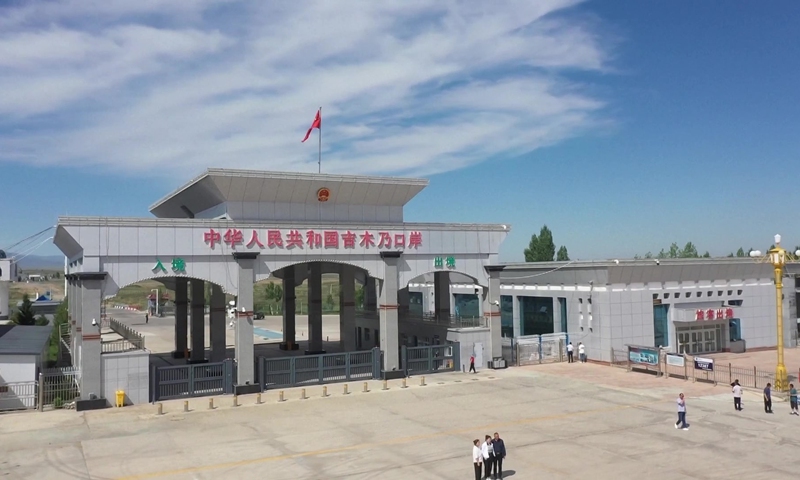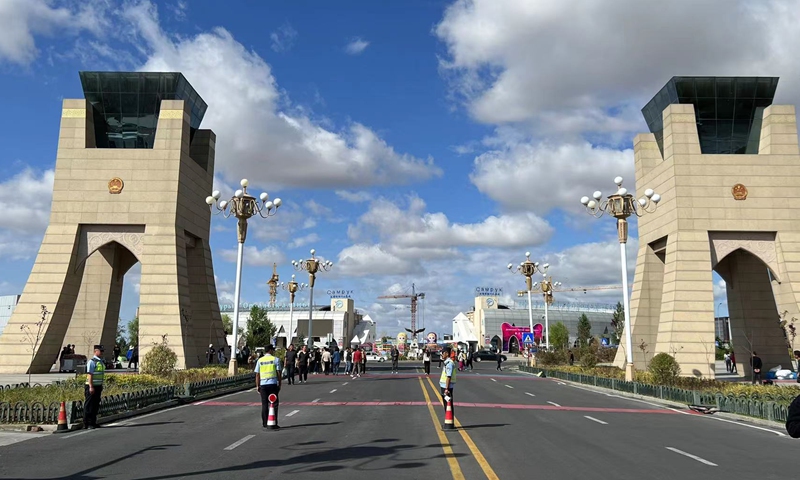
A Chinese border crossing checkpoint going into Xinjiang. Photo: CFP.

Orinoco Tribune – News and opinion pieces about Venezuela and beyond
From Venezuela and made by Venezuelan Chavistas

A Chinese border crossing checkpoint going into Xinjiang. Photo: CFP.
A decade of BRI development transforms the region into a core area of the Silk Road Economic Belt.
On Sunday morning, workers were harvesting grapes on farmland in Yining county in Kazak Autonomous Prefecture of Ili, Northwest China’s Xinjiang Uygur Autonomous Region. The freshly-picked fruit was then uploaded onto a truck, headed to Kazakhstan via highway, and within six hours, it would be delivered to the Kazakhstani market and sold to the local consumers.
“It used to take two to three days to ship goods from Xinjiang to Kazakhstan, but the time has been reduced to only half a day since the development of the Belt and Road Initiative (BRI), under which connectivity has been facilitated and the efficiency of customs clearance has been largely improved,” Yu Chengzhong, chairman of Horgos Jinyi International Trade Co, told the Global Times.Yu’s company is growing quickly thanks to fruit exports from Xinjiang, including apples, nectarines, grapes, peppers, tomatoes, prunes and cucumbers to markets in Central Asia, Russia, and Southeast Asian countries such as Thailand and Vietnam. It is expected that the company’s export value to Central Asia could climb up to $1.2 billion this year, almost doubling from $683 million recorded last year.
As business expands, the company is now constructing a 500,000-square-meter overseas warehouse in Alma-Ata in southern Kazakhstan, and it is scheduled to be put into use in October 2024. “It will be built into a distribution center covering other Central Asian countries and Russia. We will also set up an exhibition area for China-produced vehicles, as those autos have been gaining popularity in those markets,” Yu added
Yu’s company is one among the thousands of firms in Xinjiang whose businesses have been taking off under the BRI.
As the China-proposed BRI being materialized over the past decade, Xinjiang – which sits at China’s westernmost frontier bordering eight countries including Mongolia, Russia, Kazakhstan, Kyrgyzstan, Tajikistan, Afghanistan, Pakistan and India – has been transformed from a relatively closed inland region to a frontier of opening-up.

As an important node along the BRI, the region, leveraging its strategic location, has built up an overarching rail, road and flight transportation network that not only fosters closer trade and economic ties with Central Asia and Europe, but also shapes itself into a bridgehead for westward opening-up, company representatives and local officials noted.
“What we felt most during the past 10 years is that Xinjiang is no longer a remote region, but it is now becoming a core area of the Silk Road Economic Belt. We’re a pivotal international logistic hub placed at the Asia-Europe ‘golden passage.’ And the region is set to be designated with more important missions in the country’s further opening-up,” Zhao Yi, general manager assistant at International Land Port in Urumqi, told the Global Times.
Belt and Road Initiative Introduces Key Tenets of Chinese Philosophy to Wider World